With spacious open areas, Montana is one of the states that has the best grass. Cattle flourish all summer. Montana is home to over 500 species of mammals and birds combined, from tiny insects and rodents to huge carnivore predators. Because of its geographical advantage, many animals can thrive in this state today and even during prehistoric times.
Montana is abundant in dinosaur fossils. Some of the first specimens of dinosaurs were discovered in Montana. Studies show that the fossil distribution in the Hell Creek Formation in Montana and North Dakota had a 3-meter gap. This abundance of dinosaur remains takes us back to Montana’s prehistoric era. Here are seven extinct animals that lived in Montana.
1. Tyrannosaurus Rex

The first holotype of Tyrannosaurus Rex, AMNH 973 (now reconstructed as CM 9380), was discovered by Barnum Brown in 1902.
©iStock.com/para827
| Tyrannosaurus Rex | |
|---|---|
| Kingdom | Animalia |
| Phylum | Chordata |
| Class | Reptilia |
| Order | Saurischia |
| Sub-Order | Theropoda |
| Family | Tyrannosauridae |
| Genus | Tyrannosaurus |
| Species | Tyrannosaurus Rex (other species in the latest studies are Tyrannosaurus Imperator and Tyrannosaurus Regina) |
| Living Period | Late/Upper Cretaceous – 65 million years ago |
Tyrannosaurus rexes were often called “The Tyrant Kings,” and rightfully so because they were the top predator during the Jurassic Period. They ate other species of dinosaurs, and other studies concluded that they also ate their kind. Tyrannosaurus rexes were believed to be cannibals because four of their skeletons had evident tooth marks made by large carnivores. These dinosaurs were the only large carnivores known from the Late Maastrichtian of western North America.
The only chance a herbivore dinosaur would survive a T. rex attack is if it had huge horns that it could use as a defense mechanism. This meat-eating dinosaur weighed up to 18,000 pounds (9 US tons) and grew as tall as 12 to 13 feet (144 to 156 inches) off the ground, and a total of 40 feet (480 inches) long.
The first holotype of a Tyrannosaurus rex, AMNH 973 (now reconstructed as CM 9380), was discovered by Barnum Brown in 1902. It was found in the Hell Creek Formation, located in Quarry No. 1, near Jordan, in Garfield County, Montana. Six years after AMNH 973 was discovered, Brown discovered another Tyrannosaurus rex specimen called AMNH 5027, which was 11% of the skeleton by bone count and was considered the most complete skeleton of Tyrannosaurus rex ever found.
2. Velociraptor
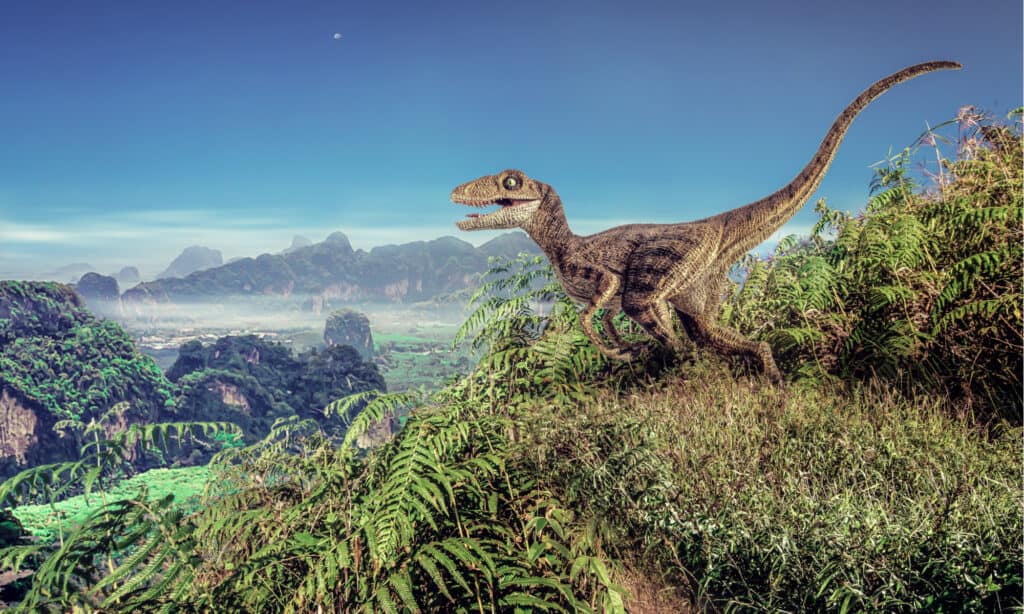
Velociraptors were often called “raptors,” which was derived from a Latin word meaning thief, robber, or predator.
©kamomeen/Shutterstock.com
| Velociraptor | |
|---|---|
| Kingdom | Animalia |
| Phylum | Chordata |
| Clade | Dinosauria |
| Clade | Saurischia |
| Clade | Theropoda |
| Family | Dromaeosauridae |
| Clade | Eudromaeosauria |
| Subfamily | Velociraptorinae |
| Genus | Velociraptor |
| Species | Velociraptor mongolienses Velociraptor osmolskae |
| Living Period | Late/Upper Cretaceous – 85.8 to 70.6 million years ago |
Velociraptors were often called “raptors,” which was derived from a Latin word meaning thief, robber, or predator. According to the studies, the term “raptor” was typically used to describe hawks, eagles, owls, and vultures. But it is now commonly associated with Velociraptors since the release of the Jurassic Park movie.
Velociraptors are from the Theropod clade, where the famous Tyrannosaurus rex belongs. The most distinctive attributes that theropods have are their three-toed limbs and hollow bones. In 1999, studies described Velociraptors as cursorial, moderately fast carnivores with large, rostrolaterally facing eyes. John H. Ostrom’s 1960 expeditions to Montana resulted in the first discovery of these species. Ostrom’s study in 1969 described the specimen that belonged to the Dromaeosauridae family.
3. Triceratops
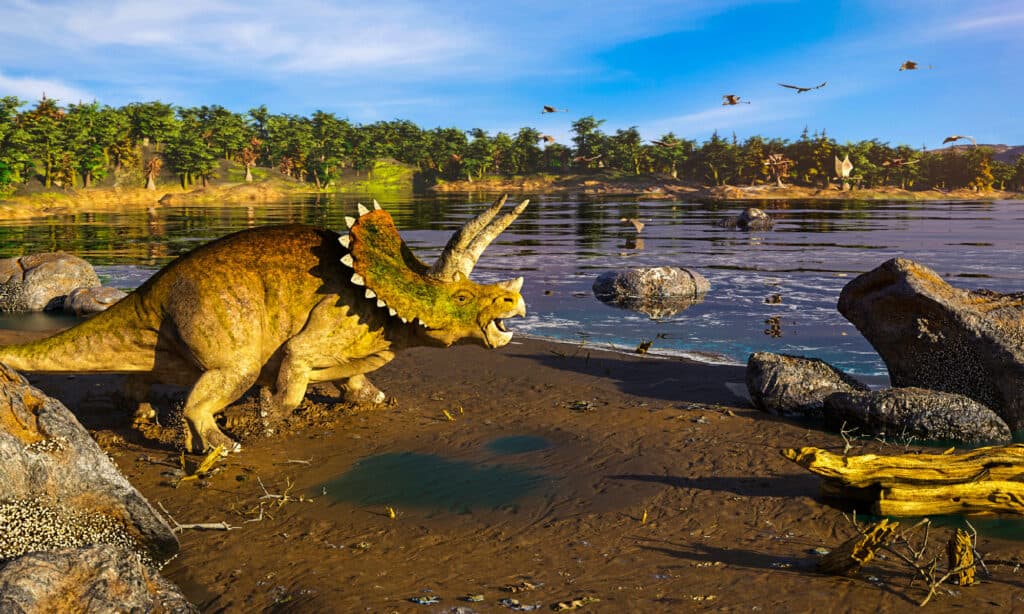
Triceratops were three-horned herbivorous dinosaurs.
©iStock.com/dottedhippo
| Triceratops | |
|---|---|
| Kingdom | Animalia |
| Phylum | Chordata |
| Class | Reptilia |
| Order | Ornithischia |
| Sub-Order | Ceratopsia |
| Family | Ceratopsidae |
| Genus | Triceratops |
| Species | Triceratops horridus Triceratops prorsus |
| Living period | Late/Upper Cretaceous – 66 million years ago |
Triceratops were three-horned herbivorous dinosaurs. They were unique in how they interacted with each other and their predators. Unlike other herbivores, scientists believed the Triceratops used their horns as a defense mechanism.
When Triceratops was first discovered in Montana, specimens were already found from the Lance Formation of Wyoming. The discovery of Triceratops in Montana piqued paleontologists’ interest in the location. According to research, over 50 skulls of the horned Triceratops were found in the Upper Cretaceous Hell Creek Formation of Montana.
4. Brachylophosaurus
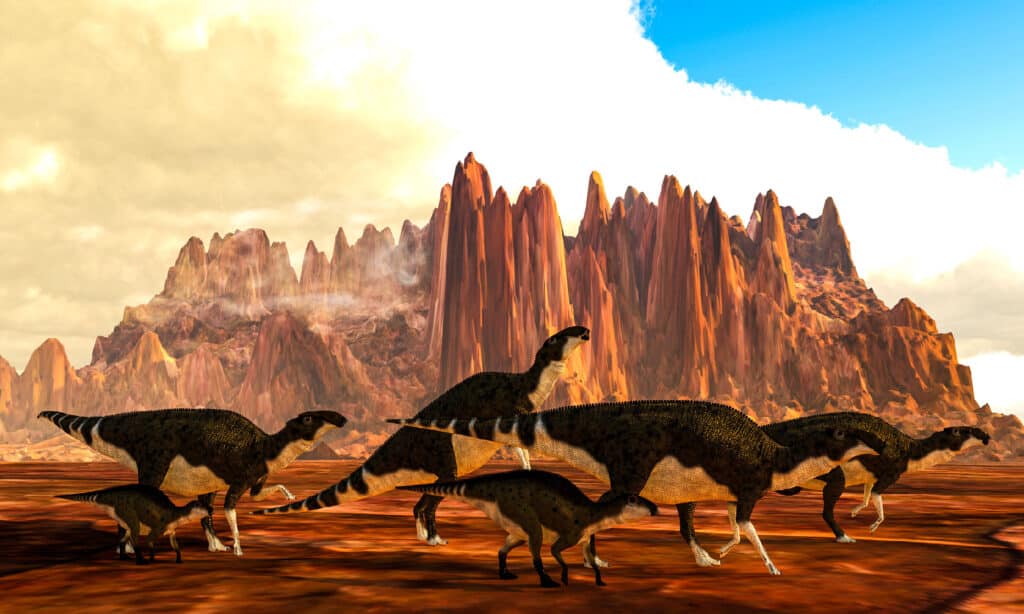
Brachylophosaurus were herbivore dinosaurs from the Hadrosauridae family.
©iStock.com/CoreyFord
| Brachylophosaurus | |
|---|---|
| Kingdom | Animalia |
| Phylum | Chordata |
| Clade | Dinosauria |
| Order | Ornithischia |
| Clade | Ornithopoda |
| Family | Hadrosauridae |
| Subfamily | Saurolophinae |
| Tribe | Brachylophosaurini |
| Genus | Brachylophosaurus |
| Species | Brachylophosaurus canadensis |
| Living Period | Late Cretaceous (Middle Campanian) – 83.5 to 70.6 million years ago |
Brachylophosaurus were herbivore dinosaurs from the Hadrosauridae family. Hadrosaurids were known to be duck-billed, meaning they had long, flat nasal bones like a duck’s bill. They grew up to 36 feet (432 inches) long and weighed up to 15,400 pounds (7.7 US tons). An exceptionally preserved specimen of Brachylophosaurus was found in the Judith River Formation of Montana. Reports showed that the gut contents of the said specimen consisted of abundant plant fragments.
5. Albertonykus
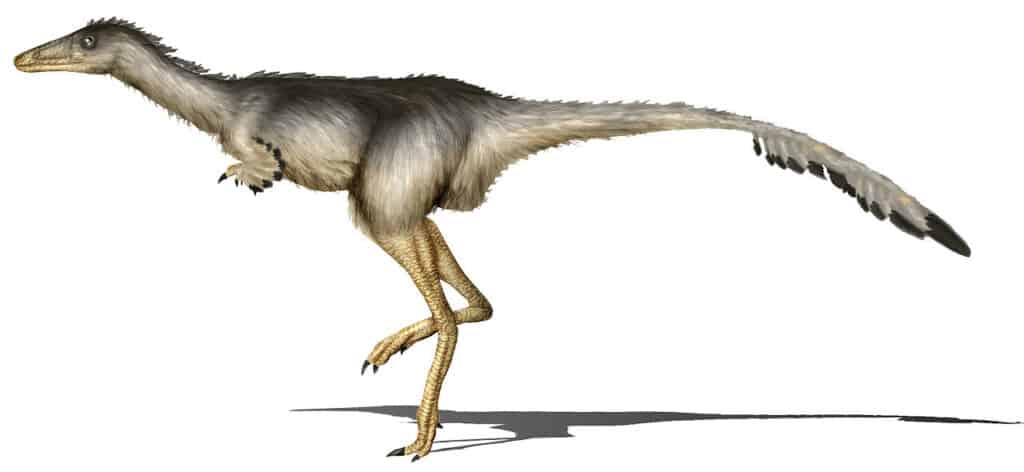
Albertonykus borealis was a species from the Alvarezsaur family.
©Karkemish / CC BY 3.0 – License
| Albertonykus | |
|---|---|
| Kingdom | Animalia |
| Phylum | Chordata |
| Subphylum | Vertebrata |
| Class | Reptilia |
| Family | Alvarezsauridae |
| Genus | Albertonykus |
| Species | Albertonykus borealis |
| Living Period | Late Cretaceous – 70.6 to 66.0 million years ago |
Albertonykus borealis was a species from the Alvarezsaur family that was first discovered in the Horseshoe Canyon Formation, Alberta, Canada. Specimens of Albertonykus borealis were also found in the Hell Creek Formation in Montana and the Lance Formation in Wyoming.
According to studies, the forelimbs of Albertonykus were specialized for digging, but unlike the other species from the Alvarezsaur family, they were too short to permit burrowing. This indicates the probability that these species used them to dig insect nests, like wood termites.
6. Diplodocus
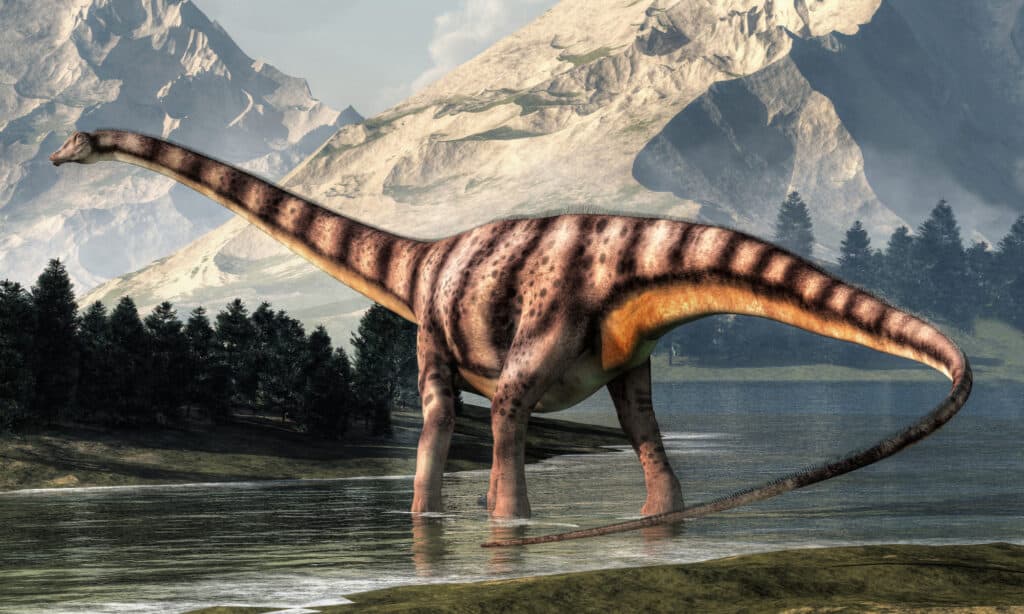
Diplodocus were herbivores with long necks and long tails.
©Daniel Eskridge/Shutterstock.com
| Diplodocus | |
|---|---|
| Kingdom | Animalia |
| Phylum | Chordata |
| Clade | Dinosauria |
| Clade | Saurischia |
| Clade | Sauropodomorpha |
| Clade | Sauropoda |
| Family | Diplodocidae |
| Genus | Diplodocus |
| Species | Diplodocus longus |
| Living Period | Late Jurassic (Kimmeridgian/Tithonian) − 154 million years ago |
The Diplodocus was a herbivore with a long neck and tail. It weighed up to 125 tons, stood 13 feet tall, and grew to 105 feet long. It could live up to 70 to 80 years. The first Diplodocus specimen (AMNH 5855) was collected by B. Brown in Montana in 1903.
7. Stegosaurus

Paleontologists reported two new partial skeletons of Stegosaurus from the Upper Jurassic Morrison Formation of Montana in 2019.
©Daniel Eskridge/Shutterstock.com
| Stegosaurus | |
|---|---|
| Kingdom | Animalia |
| Phylum | Chordata |
| Clade | Dinosauria |
| Order | Ornithischia |
| Clade | Thyreophora |
| Suborder | Stegosauria |
| Family | Stegosauridae |
| Genus | Stegosaurus |
| Species | Stegosaurus stenops |
| Living Period | Late Jurassic (Kimmeridgian) − between 159 million to 144 million years ago |
The Stegosaurus was a herbivore dinosaur. Its most distinctive attributes were the kite-shaped upright plates along its back and spikes on its tails. Paleontologists reported two new partial skeletons of Stegosaurus from the Upper Jurassic Morrison Formation of Montana in 2019. According to the report, while the stegosaurs of the Morrison Formation consist of Alcovasaurus, Hesperosaurus, and Stegosaurus, the only positively identified Stegosaur from Montana thus far is Hesperosaurus.
The photo featured at the top of this post is © Daniel Eskridge/Shutterstock.com
Thank you for reading! Have some feedback for us? Contact the AZ Animals editorial team.






